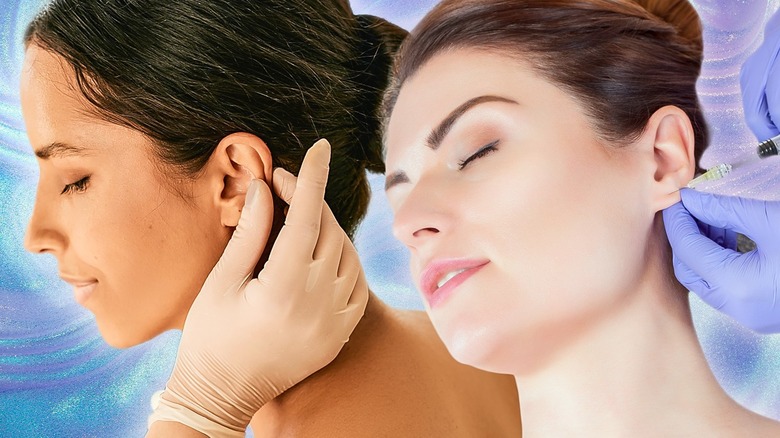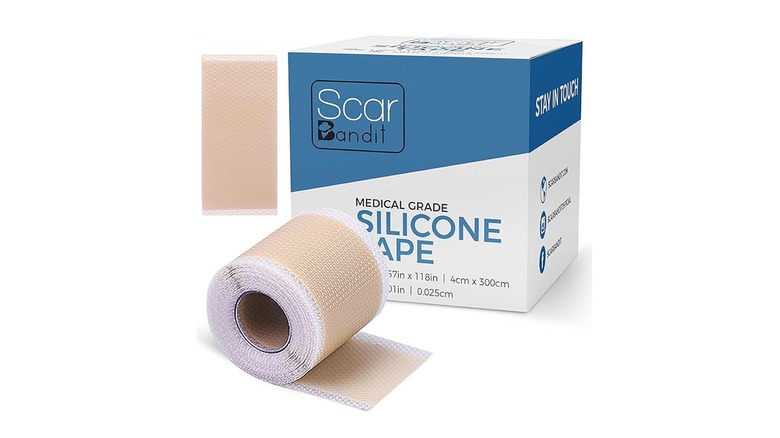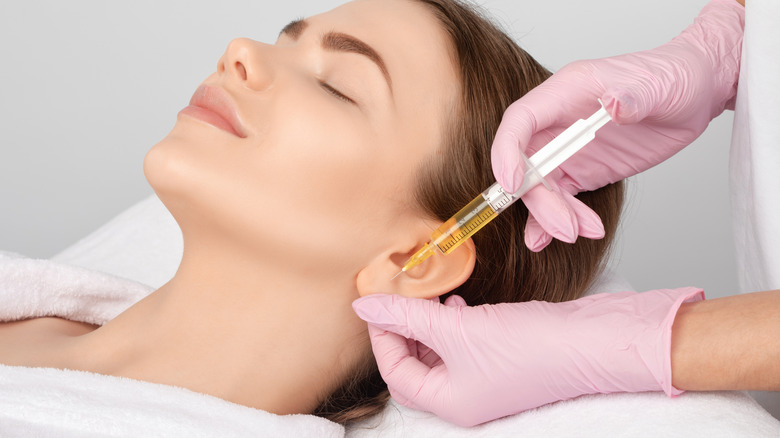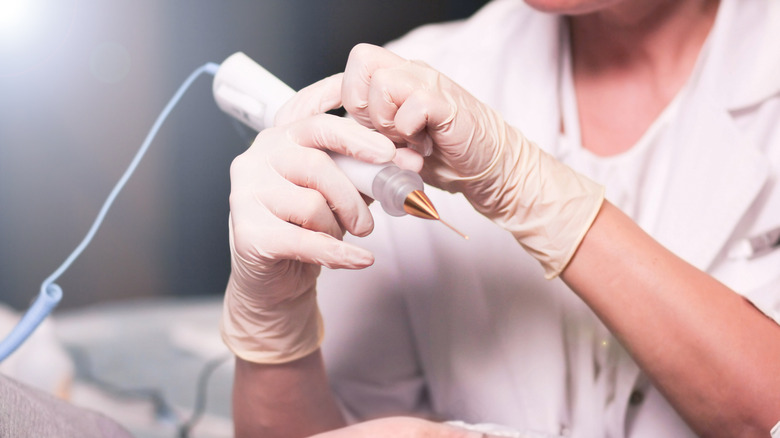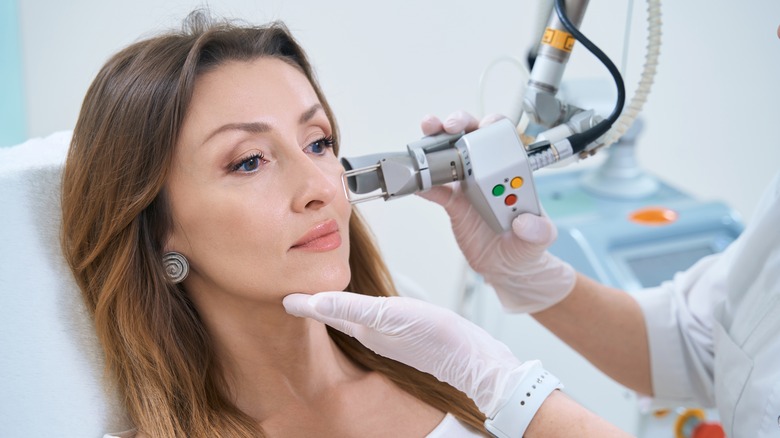How To Treat Keloid Scars From Piercings
We may receive a commission on purchases made from links.
A keloid is a raised, thick piece of scar tissue that can form around any injury, but is frequently associated with ear piercings. If you've ever noticed a shiny or misshapen bump on the back of your ear piercing, for example, you may have experienced a keloid scar. These bumps can range from small and merely annoying to very large and disfiguring — even engulfing the entire ear in some cases.
While it is possible to surgically remove a keloid scar, surgery carries a high rate of recurrence — along with the risks inherent in surgery — and when a keloid scar recurs, it can come back even bigger than it was before. Thankfully, there are several other treatments options that can be attempted before or in combination with surgery — ranging from simple wound dressing to laser removal therapy. If you have keloid scars, there's no reason to suffer; there are plenty of different ways to go about easing your symptoms.
Compression or silicone bandaging
The best time to treat a keloid scar — according to the Mayo Clinic — is right after it emerges, before it grows to an unmanageable size. If you notice a keloid forming, applying pressure to the scar using a compression bandage can help to flatten the scar tissue as it heals. Compression earrings — which consist of what amounts to a small clamp for applying pressure to a keloid for up to 24 hours per day — are also available and are commonly prescribed to prevent recurrence after a keloid scar is surgically removed.
Keloid scars in the early stages of development can also respond very favorably to silicone bandages, sometimes referred to as scar sheets, scar patches, or scar tape. Covering a keloid with a silicone bandage can increase hydration, help with hydration, and reduce itching, cell proliferation, and pigmentation, per the Journal of Clinical and Aesthetic Dermatology. Over-the-counter wound care should be the first step to treating your keloid scar and preventing it from developing further.
Topical or injected corticosteroids
When simple wound care isn't enough to effectively treat a keloid, the next line of defense is topical corticosteroid medications. These creams and gels can be applied directly to the keloid scar. There are many corticosteroid-based products on the market that claim to be able to shrink your keloid bump. However, most keloid scars will require stronger active ingredients — which must be prescribed by a dermatologist — and even then, you're more likely to see an improvement in itching and irritation than any actual shrinking, per the Mayo Clinic.
If you have been prescribed a topical corticosteroid medication and have not seen improvement of your symptoms, an injectable corticosteroid medication — sometimes mixed with a chemotherapy medication — is likely the next step, according to the London Cosmetic Clinic. Your dermatologist will inject the medication mixture directly into the keloid scar. The corticosteroid medication will reduce inflammation and blood flow within the scar and the chemotherapy medication will attack the tumorous cells with it. The injection will be repeated on approximately a monthly basis until the keloid has significantly improved.
Cryosurgical removal
If you've ever had a wart removed via freezing, you are familiar with cryosurgical removal. This method involves applying liquid nitrogen to a keloid in order to freeze the tissue at nearly -300°F. After a cryosurgical removal procedure, a keloid scar can be expected to swell with fluid that will eventually drain. Once this drainage has taken place, a scab will form over the site. Eventually, the scab will naturally fall away and at least part of the keloid will fall off with it, per the Cryo Bar.
In most cases, cryosurgical removal will need to be performed more than once to fully remove a keloid scar. While the procedure can be quite painful in the case of large keloids, it is generally easier and more cost effective than traditional methods of surgical removal. However, loss of pigment in the affected area (hypopigmentation) is a common side effect, especially in people with dark skin.
Laser removal
For large, thick keloids that might be difficult to remove with cryosurgery, laser removal may be an option. During laser therapy, a pulsed-dye laser is used to apply heat to the abnormal blood vessels within the keloid. Due to the heat associated with laser treatments, patients can expect to experience some pain, blistering, and scabbing or crusting of the keloid area after the procedure, per the Mayo Clinic. Much like cryosurgical removal, laser removal typically requires multiple sessions to fully remove the keloid and can result in hypopigmentation — especially for dark-skinned patients — who are also more likely to suffer from keloid scarring, according to the American Academy of Dermatology Association.
Unlike cryosurgical removal treatments, laser removal treatment can also cause excess pigment to form in the area (hyperpigmentation), especially in darker-complected individuals. These side effects will typically fade over time and are often considered preferable to the irritation and cosmetic concerns that living with a large or unsightly keloid scar can bring to your life.
Ligature or surgical removal
When a keloid becomes very large or is not responsive to medication, cryosurgical removal treatments, or laser removal treatments, ligature or surgical removal may become necessary. In some cases — before attempting surgery — a surgical thread will be tied tightly around the keloid. Several new threads will be placed over a period of weeks in hopes of cutting off the blood supply to the scar tissue. If the procedure is successful, according to Northwestern Medicine, the keloid will dry up and detach from the skin once it has no blood supply.
If ligature removal is not an option or doesn't work, surgery can be performed to remove the keloid using a manual incision. After the scar tissue has been removed, the incision will typically be closed using sutures. However, removal of a very large keloid may require a skin graft to successfully close the surgical wound. Unfortunately, surgical removal without additional treatment results in 70-90% of keloid scars recurring at some point, according to the International Keloid & Scar Treatment Center.
Superficial radiation therapy
The high rate of recurrence for keloids that require surgical removal creates a necessity for additional treatment to help prevent keloid scars from coming back. The most effective post-surgery treatment for lowering the risk of recurrence — according to International Keloid & Scar Treatment Center — is superficial radiation therapy. Superficial radiation therapy penetrates only the outermost layers of the skin in order to kill the abnormal cells within the keloid without risking the side effects of a full radiation treatment.
When followed by a series of superficial radiation treatments, the post-surgical recurrence rate of keloid drops from 70-90% to just 5-10%. Developing a keloid scar can turn your fun piercing into a regrettable nightmare. Fortunately, these treatment options can get you back to looking and feeling like yourself again. If you're suffering with keloid scarring, don't hesitate to seek medical attention to get the treatment you need to recover. As reported by Everyday Health, keloids often grow bigger and more difficult to remove over time.
